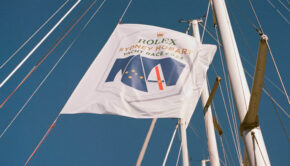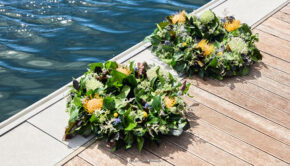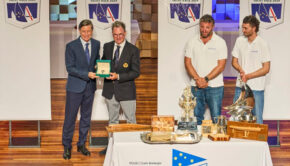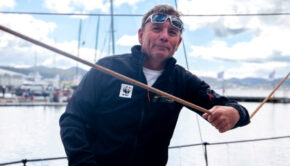Comanche: Strengths and weaknesses revealed
Published on December 29th, 2014
The racing debut of the 100-foot Comanche from designers Guillaume Verdier and VPLP Architects confirmed a few things. She is sticky in light winds, the Rolex Sydney Hobart Race could reveal this, and she is explosive in the right conditions.
The right conditions were revealed early in the race as she lead the fleet out of the Harbour in one of the most spectacular, high speed starts in the race’s history. Designed for fast broad reaching, the 15 knot plus south-easterly breeze on the harbour was made to order for the big red and black hulled yacht owned by American Jim Clark and his Australian wife, Kristy.
After a brilliant start slightly ahead and to leeward of Wild Oats XI, Comanche swiftly unfurled her giant spinnaker and took off, quickly ‘rolling the Oats’, causing skipper Mark Richards to exclaim from the wheel of Wild Oats XI “She’s smoking – look at that thing go.”
But a ridge of high pressure in the Bass Strait highlighted Comanche’s weakness, as light air and a bumpy sea gave Wild Oats XI the opportunity to pass and extend to win line honors by 49 minutes.
“Both boats sailed a flawless race; but they had their day,” noted Comance skipper Ken Read. “They had 12 hours where they had Wild Oats’ weather, but that’s racing.”
So after this first race have they identified any changes they will make to the boat?
“It’s brand new, we’re just starting,” admitted Read. “Before this race started, we didn’t know what we didn’t know. We knew we had a good boat right off the start line, the way it just took off on that windy reach. Unfortunately we’ve always known we had that one blemish in light air, and that became a dominant feature in the race, so that’s unfortunate for us.”
America’s Cup winning skipper Jimmy Spithill, one of six helmsmen on Comanche, shared that the boat reached a top speed of 32 knots.
“Everybody got to see the true potential of this boat at the start. I remember looking up at Kenny and he just had this huge grin from ear to ear. Unfortunately we just didn’t see those sort of conditions again until the end of Bass Strait.”
Designer Xavier Guilbaud said he couldn’t take his eyes off the yacht tracker, keeping notes as Comanche changed angles and the wind circled the compass.
“On top of my own list, what I can see, is work on the weight of the boat to try to lighten her up a bit more, to increase performances in light winds,” he said.
“I’ll discuss with the guys here, a little later, the little bits and pieces on the deck to improve manoeuvres, how the boat is sailed. Then on the sail configuration; how to use each sail, in which condition and improve the sail shapes.
“I think we do have a record breaker on our hands. The real answer will be in June next year when it does the Transatlantic Race. I think the boat is really fast.”
By Bruce Montgomery, RSHYR media
Background: One hundred seventeen teams entered the 628 nm Rolex Sydney Hobart Yacht Race. Starting on December 26, the fleet exits Sydney Harbor and heads down the south-east coast of mainland Australia, across Bass Strait, then down the east coast of Tasmania. At Tasman Island the fleet turns right into Storm Bay for the final sail up the Derwent River to finish in Hobart.








 We’ll keep your information safe.
We’ll keep your information safe.